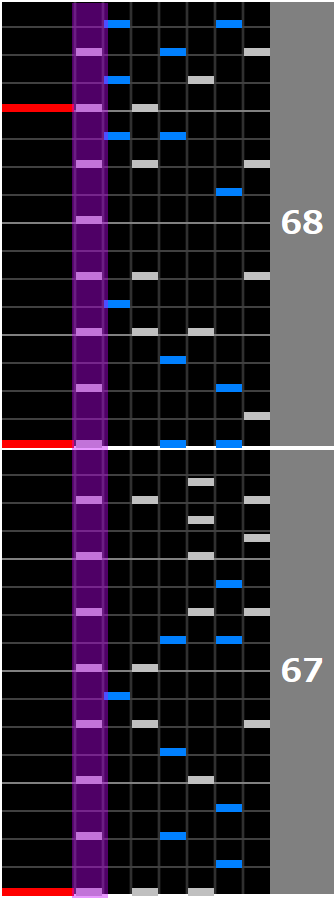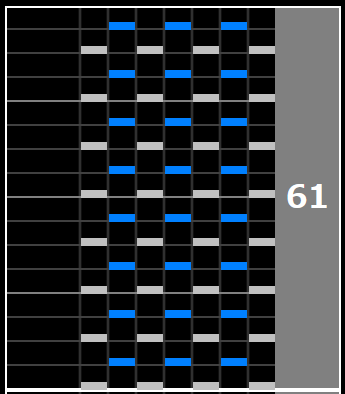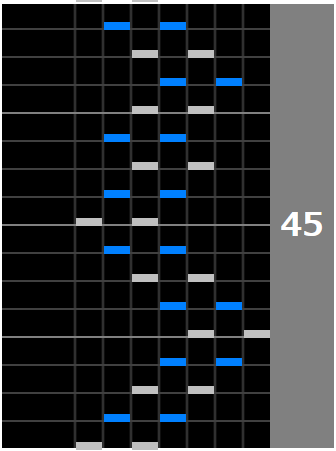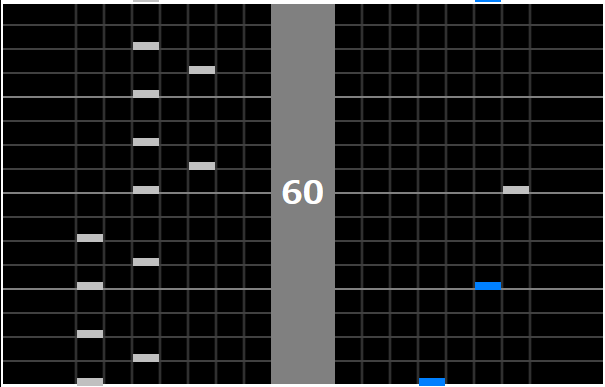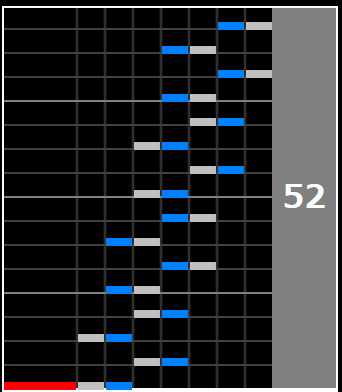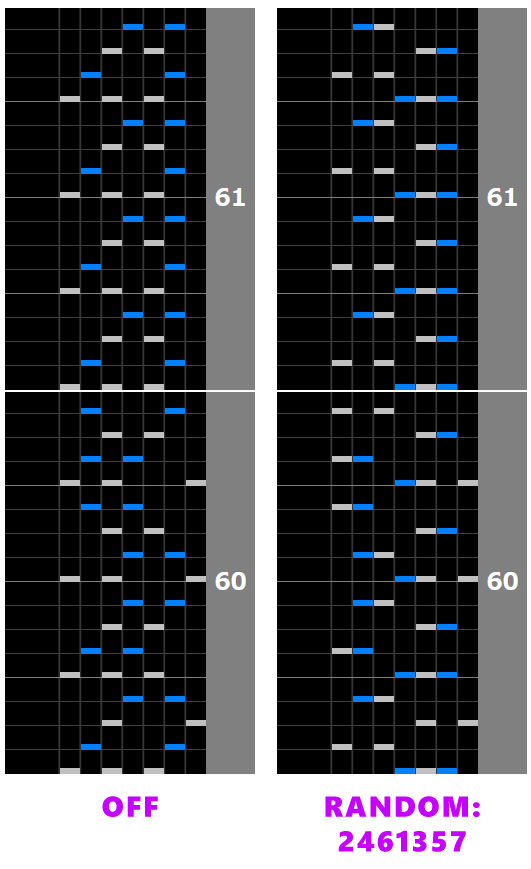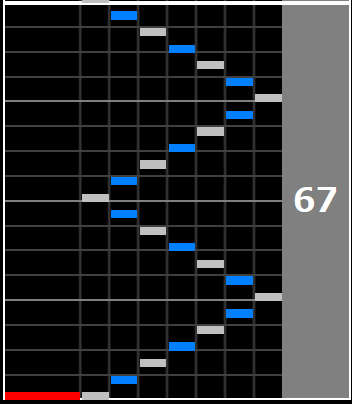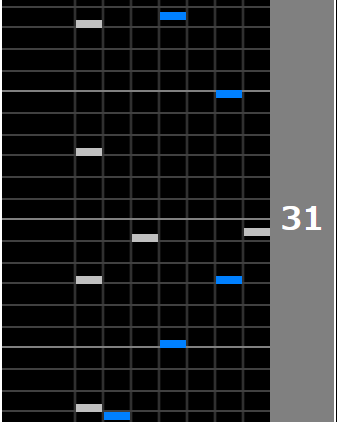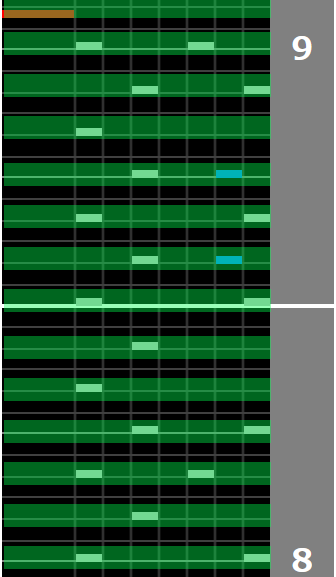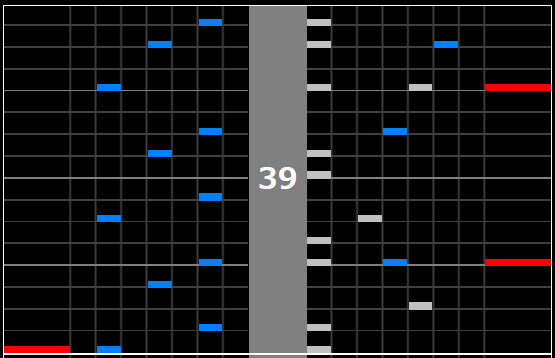beatmania IIDX SP / DP Common Terminology in English, Japanese, and Korean
Table of contents
- Introduction
- General
- AAA
- All-easy clear / all-green
- All-hard clear / all-white
- All-time record
- Another
- Bad random
- BP
- Buttons
- Dan (Class)
- Earth power
- Ex-hard gauge
- Excessive POOR
- Full combo
- Good random
- Green number
- Hand cam
- Hard gauge
- Hard ending
- IIDX
- Individual difference
- Insane BMS
- MAX
- Mirror
- OFF (no option)
- Perfect
- Random (the option)
- Scratch
- Springs
- Sight read
- Switches
- White number
- Mindblock / Curse / Bad habits
- Patterns
- Techniques
- DP specific terms
- References
Introduction
This is by no means a complete set of vocabulary used by IIDX players, but I will try to cover the common ones used in conversations and explain their meanings / origins wherever possible. Japanese, Korean, and English are the three commonly used languages in the community, so the equivalents will be covered in all three.
General
AAA
- 🇯🇵 鳥
- 🇰🇷 트리플
When you get a triple-A result - see here for details.
鳥 is pronounced “tori” as in “triple”. In Korean 트리플 (triple) is seldomly used in conversations. Most people just say AAA when writing.
All-easy clear / all-green
- 🇯🇵 全綠
- 🇰🇷 표록
When you get the easy clear lamp or above on all songs (typically for a folder, usually level 12).
全綠 is “all green” since the easy clear lamp is green in color. 표록 is a made up word as a variation of 표백.
All-hard clear / all-white
- 🇯🇵 全白
- 🇰🇷 표백
When you get the hard clear lamp or above on all songs (typically for a folder, usually level 12).
全白 is “all white” since the hard clear lamp is white in color. 표백 means to “bleach”.
All-time record
- 🇯🇵 歴代
- 🇰🇷 역대
The word 歴代 / 역대 refer to “all time” as in all-time high score records set across past and present versions.
Another
- 🇯🇵 穴
- 🇰🇷 어나더
The Another difficulty of a chart, as opposed to Normal or Hyper. 穴 is pronounced “ana” as in “another”, an ateji.
Bad random
- 🇯🇵 はずれ, ハズレ
- 🇰🇷 똥배치, 똥배
When the random option results in a “bad” pattern, making it particularly harder to clear or to score.
BP
BP = Bad Poor = Miss Count
GBP = Good Bad Poor
Buttons
- 🇯🇵 ボタン
- 🇰🇷 버튼
Dan (Class)
Here is the list of class mode ratings (dans). Going from lowest to the highest:
Kyu
- 七級 7급 7th kyu
- 六級 6급 6th kyu
- 五級 5급 5th kyu
- 四級 4급 4th kyu
- 三級 3급 3rd kyu
- 二級 2급 2nd kyu
- 一級 1급 1st kyu
Dan
- 初段 초단 shodan (1st dan)
- 二段 2단 2nd dan
- 三段 3단 3rd dan
- 四段 4단 4th dan
- 五段 5단 5th dan
- 六段 6단 6th dan
- 七段 7단 7th dan
- 八段 8단 8th dan
- 九段 9단 9th dan
- 十段 10단 10th dan
- 中伝 중전 chuuden
- 皆伝 개전 kaiden
Earth power
- 🇯🇵 地力
- 🇰🇷 지력
Measure of your base ability to read and hit notes. Also (loosely) used as a measure of your skill level, sometimes with a quantitative measurement using a numeric score based on some formula; for example, Insane BMS recommend rating, or ereter.net clear ability rating. Usually this excludes skills that would be considered individual difference, such as scratches, sof-lan, charge notes, and so on.
The term “earth power” is a literal translation of 地力 that perhaps started out as a joke, but it stuck with the community.
Ex-hard gauge
- 🇯🇵 エクハ
- 🇰🇷 익스, 익하, 노랑게이지, 노랑게
The ex-hard gauge option - see this page for details.
노랑게이지 means yellow gauge.
Excessive POOR
- also: empty POOR, excess POOR, mash POOR
- 🇯🇵 空POOR
- 🇰🇷 공푸어
A POOR judgement that can be generated before or after a note’s timing window. In IIDX, if you press a button well before the note, you can get an excessive POOR; additionally, if press the button again right after getting a judgement (BAD or higher), you can also get an excessive POOR.
See IIDX Gauge Calculation and Timing Windows and IIDX LR2 beatoraja differences pages for more information.
Full combo
- 🇯🇵 フルコン
- 🇰🇷 풀콤
Getting a full combo (no combo breaks) in a chart.
Good random
- 🇯🇵 当たり, あたり
- 🇰🇷 황금배치, 황배
When the random option results in a “good” pattern, making it significantly easier to clear or to score.
Green number
- also: GN
- 🇯🇵 緑数字
- 🇰🇷 녹숫
Lit. “green number” in all three languages. GN indicates how fast notes come down from the top, commonly referred to as “scroll speed” in other rhythm games. See here for more details.
Hand cam
- also: hand shot
- 🇯🇵 手元
- 🇰🇷 손캠
Camera footage focused on hands of a player, or the camera itself.
Hard gauge
- 🇯🇵 ハード, 難
- 🇰🇷 하드게이지, 하드게, 하드클, 빨강게이지, 빨강게
The hard gauge option - see this page for details.
빨강게이지 means red gauge.
Hard ending
- also: difficult ending
- 🇯🇵 ラス殺し
- 🇰🇷 후살
On easy / normal gauge, even if you had 100% gauge throughout the song, if you miss notes near the end of the song, you can fail the stage. This is commonly referred to as ラス殺し or 후살 although in English people just say something to the effect of difficult end part.
IIDX
- 🇯🇵 弐寺
- 🇰🇷 투덱, 비트
Individual difference
- 🇯🇵 個人差
- 🇰🇷 개인차
Contrasted with earth power, these are set of skills that are outside of just hitting the buttons, and charts that include many examples of these elements. This would include scratches, charge notes, sof-lan, and charts heavy on jacks or chords.
Insane BMS
- 🇯🇵 発狂BMS
- 🇰🇷 발광BMS, 발광븜스
High-level BMS charts, and community-curated collection of charts, and difficulty tables. See this page for details.
MAX
- 🇯🇵 理論値
- 🇰🇷 이론치
MAX refers to receiving the theoretical maximum score (all PGREATS). MAX-10 would be being 10 points away from MAX.
理論値 / 이론치 mean “theoretical value” commonly used in other games but in IIDX people usually just say MAX.
Mirror
- also: mir
- 🇯🇵 鏡, ミラー
- 🇰🇷 미, 미러
Play option used to flip the lanes horizontally, see this page for details.
OFF (no option)
- also: options off, normal, nonran, non-ran
- 🇯🇵 正規
- 🇰🇷 정배, 정배치
Playing without random or mirror options enabled.
Perfect
Perfect refers to receiving PGREAT or GREAT judgement on every note. Excessive POORs are irrelevant.
Random (the option)
- also: ran
- 🇯🇵 乱
- 🇰🇷 랜덤
Play option used to randomly change the order of lanes or notes; see this page which also explains S-RANDOM, R-RANDOM, H-RANDOM, M-RANDOM, MIRROR, FLIP, BATTLE, SYNCHRONIZE RANDOM, and SYMMETRY RANDOM.
乱 is an ateji of a kanji that happens to be pronounced “ran”.
Scratch
- 🇯🇵 皿
- 🇰🇷 접시, 스크
Turntable notes, as in record scratch. Used as a verb (to scratch) and also a noun (scratch notes).
皿 and 접시 are “plates”.
Springs
- 🇯🇵 バネ
- 🇰🇷 스프링
Sight read
- also: first play, first try
- 🇯🇵 初見
- 🇰🇷 초견
Playing a song or chart for the first time without any prior knowledge.
Switches
- also: microswitches
- 🇯🇵 スイッチ, マイクロスイッチ
- 🇰🇷 스위치, 마이크로스위치
White number
- also: WN
- 🇯🇵 白数字
- 🇰🇷 흰숫
Lit. “white number” in all three languages. WN indicates how much of the play area is covered by SUDDEN+ or LIFT. See here for more details.
Mindblock / Curse / Bad habits
- 🇯🇵 癖 (くせ)
- 🇰🇷 저주, 습관
The concept of being blocked by a particular pattern, specific section of a chart, or the entire chart, due to learned behavior.
The belief is that repeated play through of the same pattern leads to perceiving (reading) the notes incorrectly over and over, or your muscles wrongly reacting (i.e., hitting the wrong buttons or at the wrong timing) due to habitual learning process.
Usually, western players use the word mindblock for this, though it’s not 100% equivalent.
癖 (くせ / kuse) is literally translated to “bad habit(s)”. Literal translation of 저주 is curse, 습관 is habits (not necessarily good or bad).
Patterns
All press (?)
- also: all buttons (?) The Dirty of Loudness (???)
- 🇯🇵 全押し
- 🇰🇷 빅장
A chord with 7 notes, maybe with the scratch.
Bass
- also: bass rush
- 🇯🇵 バス, 軸, 裏打ち
- 🇰🇷 축, 축노트
Column of evenly spaced notes, which tend to have bass (drum beat) key sounds. 軸 / 축 means axis, which is used in the context of more complex pattern that contains a bass column.
Example above is from 卑弥呼 SPA.
Chords
- 🇯🇵 同時押し
- 🇰🇷 동시치기, 동치
A set of notes that require you to press multiple buttons at the same time, as opposed to a single note.
Delay
- 🇯🇵 ディレイ
- 🇰🇷 딜레이, 지연
This is a BMS terminology where the chart creator splits a single note into two or more, splitting the key sound audio into smaller pieces, creating more difficult chart out of an existing one.
The resulting pattern would be a zure pattern, but the word delay is also used in similar context.
Denim
- 🇯🇵 デニム
- 🇰🇷 데님, 거미줄
A pattern where succession of chords with alternating keys are presented. It comes from DENIM ANOTHER in 5-key beatmania, where this pattern was first introduced.
In the strictest sense the term denim refers to alternating blue keys - white keys. In reality people refer to any alternating & repeating chord pattern as denims (e.g., 123 - 4567 - 123 - 4567…).
Example above from V SPA.
Double stairs
- 🇯🇵 二重階段
- 🇰🇷 겹계단, 이중계단
Stair pattern, but composed of two-note chords instead of individual notes. Example above is from Verflucht SPA.
Inequality sign (?)
- also: V-shapes (?)
- 🇯🇵 くの字, 逆くの字
- 🇰🇷 부등호
Refers to patterns shaped like > and <, a set of three (or more) notes where it moves in one direction and then quickly changes to the other.
くの字 is basically “looks like く”, 부등호 means mathematical inequality symbols.
Example above is from SigSig DPA, where the left hand shows this pattern.
Jacks
- 🇯🇵 縦連, 縦連打, 連打
- 🇰🇷 연타
Rapidly repeating notes in the same column(s). Example from Scripted Connection⇒ A mix SPA.
n-th note
- also: 8th note, 16th note, 32nd note, 8ths, 16ths, 32nds
- 🇯🇵 8分, 16分, 32分
- 🇰🇷 8비트, 16비트, 32비트
Terminology that comes from music theory describing how notes are spaced apart relative to the beats-per-minute (BPM).
Pills
- also: adjacent chords, Dr. Mario
- 🇯🇵 カプセル譜面, Dr.マリオ譜面
- 🇰🇷 알약
Patterns that have double notes in adjacent lanes, more often used in scenarios where it is presented in a series like the example above in 3y3s SPA.
Speed change
- also: BPM change, soflan, sof-lan
- 🇯🇵 ソフラン
- 🇰🇷 변속
When the BPM changes during a song, causing the note’s scroll speed to change as well.
The term soflan comes from the song SOFT LANDING ON THE BODY. While this wasn’t the first chart in beatmania series to have a speed change, it was certainly the first to use it as a gimmick.
As of Heroic Verse, the game officially adopted the terminology as it is used in the chart and player radar.
Slap
- also: slap random, perfect slap
- 🇯🇵 ガチ割れ
- 🇰🇷 완분, 완전분할
Slap is a pattern that results in the player hitting note(s) with left hand, and then more note(s) with the right hand, left hand, and so on, a pattern that is easy to comprehend thanks to the “split”.
Slap random refers to a case of good random where the random results in (mostly) slap pattern. Sometimes people will say perfect slap for randoms that generate a clean split between left and right.
The example above is a slap random of Go Beyond SPA.
Stairs
- also: staircase
- 🇯🇵 階段
- 🇰🇷 계단
Note pattern that are composed of single notes going through consecutive lanes, resembling a staircase. In general they do not need to fully span all lanes to be considered a stair pattern, but they do need to have at least three notes in a sequence. Example above is from Nageki no Ki SPA.
Trills
- also: rolls
- 🇯🇵 トリル
- 🇰🇷 트릴
A sequence of alternating notes between two lanes, usually evenly spaced but not necessarily always the case.
Example above is from Colors SPA.
Zure
- 🇯🇵 ズレ, ズレ譜面
- 🇰🇷 즈레
Notes that are only slightly apart from one another, usually in 24ths or 32nds increments.
Example above is from Happy Wedding SPA. In higher difficulty charts, extremely rapid bursts of notes are also an extension of zure (e.g., the end of quell).
Techniques
Anmitsu
- 🇯🇵 餡蜜, あんみつ
- 🇰🇷 뭉게기, 안미츠
A technique where, instead of hitting notes when you should be hitting them, you hit some of them earlier or later to simplify the overall pattern. Typically, this is used to turn complex patterns into a sequence of chords. Obviously, this sacrifices scoring (timing) but this can be used to clear songs.
Here is an example of a full combo on 3y3s with anmitsu technique - pay attention to 20 second mark.
Here is another example of anmitsu taken to the extreme, for playing DBM.
Anmitsu is the name of a dessert, but also the DJ name of beatmania 5-key player who played Ska a go go with this technique and popularized it.
Bad chaining
- 🇯🇵 BADハマり
- 🇰🇷 배드밀림
In a dense (repeated notes) pattern when you end up with a series of FAST BADs.
This is due to the way IIDX timing works, a combination of:
- a (non-excessive) BAD judgement “erases” the note ahead instead of being counted for the previous note
- BAD window being extremely wide (±250 milliseconds)
Floating
- also: to float (used as a verb)
- 🇯🇵 ギアチェン, フローティング
- 🇰🇷 플로팅
The act of holding the start button and slightly moving the turntable to re-adjust the hi-speed so that it returns to the original green number, used to counteract changes in the BPM (soflan). See here for details.
Gachioshi
- also: gachi
- 🇯🇵 ガチ押し
- 🇰🇷 끊어치기
Gachi means to take things seriously, and oshi here means to push. This is a technique where horizontal reading is used to put effort into hitting each individual note and chords accurately. It could be described as seeing any pattern as a series of chords.
This is a difficult concept to explain, but a crucial in high level scoring; see article on the-safari or its English translation for full details.
Horizontal reading
- also: horizontal recognition
- 🇯🇵 横認識
- 🇰🇷 횡인식
Reading technique where you divide up the pattern into horizontal sections, recognizing them as a sequence of chords. This is in contrast to vertical reading.
Example above is from Gigadelic SPH.
See article on the-safari or its English translation for full details.
Hokuto
- 🇯🇵 北斗
- 🇰🇷 북두
Two usages:
- A playstyle where only a few fingers - usually the index, middle, and the thumb - are used to hit buttons, rapidly moving the hands around to “hunt and peck” the buttons without a well-defined playstyle. This is sometimes referred to as “freestyle” in the western communities although not entirely accurate.
- In DP, this usually refers to the technique of quickly moving the ring finger between 5 and 6, as opposed to using middle-5 or middle-6. This is also referred to as “ring slide” (약지끌기).
Has origins in Hokuto no Ken (First of the North Star).
Playstyles
- also see: 1048式, TAKA.S, べちゃ押し, symmetric (対称固定), thumb slide, 3:5, 2:5 …
- 🇯🇵 運指
- 🇰🇷 손배치, 운지법
Vertical reading
- also: vertical recognition
- 🇯🇵 縦認識
- 🇰🇷 종인식, 형인식
Reading technique where you divide up a pattern into vertical sections, reading a group of lanes separately (e.g., lanes for left hand, and lanes for right hand). This is in contrast to horizontal reading.
Example above is from Gigadelic SPH.
See article on the-safari or its English translation for full details.
DP specific terms
DB, DBM, DBR
D: Double
B: Battle
M: Mirror
R: Random
DBM is turning Battle option, and Mirror on one side (1P or 2P side), which results in a symmetric pattern where one side receives the SP pattern and other results in a mirrored version of that. Usually it also implies turning on auto scratch.
DBR is turning Battle option, and Random on one side (1P and 2P sides), resulting in randomized SP pattern on both sides. Usually it also implies turning on auto scratch.
See Random Options page for details.
Landing
- also: landing scratch
- 🇯🇵 皿着地
- 🇰🇷 착지, 착지스크
Landing as in touching down on the ground. This describes when you rapidly switch from the keys to hit the turntable.
着地 / 착지 are also sometimes used to describe doing the reverse (moving from the turntable and landing on the keys).
Impossible scratch
- 🇯🇵 無理皿
- 🇰🇷 무리스크
When you get a combination of note(s) and scratches on one that that is impossible to hit because they are too far apart. Example above is from Sweet Lab DPA; right hand gets two instance of impossible scratches in one measure.
Knight chords
- 🇯🇵 桂馬押し
- 🇰🇷 계마
Two-note chords where the notes are 2 columns apart, kind of like how knights work in chess or shogi. This isn’t really notable in SP, but in DP this can be particularly confusing, especially if you get multiple of these in a row.
In Korean 계마 is seldomly used, people typically refer to them by the button numbers (14, 25, 36, 47).
Example above is from Second Heaven DPA.
Middle-5, middle-6
- 🇯🇵 中5, 中6
- 🇰🇷 중5, 중6
DP technique of using the middle finger to press button 5 or 6. See this page for details.
Near scratch (?)
- (There isn’t a commonly used English term for this)
- 🇯🇵 隣接皿
- 🇰🇷 인접스크
When the pattern requires you to hit both the turntable and key(s) with the same hand. Example from route 80s DPA, a chart that is full of these.
Regular patterns (?)
- 🇯🇵 正規系
- 🇰🇷 정미계열, 정규계
Combination of options where only FLIP and MIRROR options are used, including the standard (OFF) pattern. There are total of 8 patterns (OFF, MIR/OFF, OFF/MIR, MIR/MIR – and FLIP version of these four).
Reverse anmitsu
- 🇯🇵 逆蜜
- 🇰🇷 역뭉게기
Technique used to “split” a chord into a series of notes instead, sacrificing timing for the sake of hitting all the notes (e.g., for full combo). Hence the name, reverse anmitsu.
This is used in DP to handle impossible scratches. Here is an example of quasar DPA (see 1:51) where left hand handles S+67 by hitting the turntable first and then quickly moving to hit 6+7.
Thumb technique
- 🇯🇵 親3, 親5
- 🇰🇷 엄지테크닉, 엄테
Making use of your thumb to cover notes other than its base position.
親3, 親5 translates to thumb-3 and thumb-5. See this page for more details.
엄지테크닉 was a term popularized by EZ2AC 10-key players where they would press the 3 key with the thumb.
Various options for DP
Use a combination of the following with options:
- left hand = 1p side = 左 = 좌
- right hand = 2p side = 右 = 우
- both sides = 両 = 쌍
- flip = フリップ = 플, 플립
e.g.,
- 1p mirror = 左鏡 = 좌미
- both side random = 両乱 = 쌍랜
See this page for details. Here is a page in Japanese with suggested options for DP charts.

